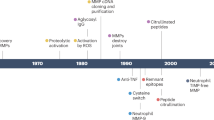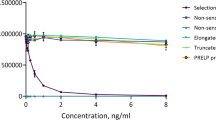Summary
Objective: The clinical activity of rheumatoid arthritis (RA) is not reliably reflected by laboratory measures. Proteolytic enzymes involved in the cascade of joint destruction are potentially useful parameters to monitor the extent of joint inflammation in RA. This study compares the validity of two classes of proteolytic enzymes, matrix metalloproteinases (MMP) and lysosomal cysteine proteinases (cathepsin B, H, and L) as well as their respective inhibitors to serve as parameters of RA disease activity.
Methods: The proteolytic activity of cathepsins B, H, and L was determined by fluorometry in sera of 20 patients with active RA and of 20 healthy donors. In addition, the concentrations of cathepsin B and L as well as of cathepsin inhibitors stefin A, stefin B, and cystatin C were measured by ELISA. The plasma concentrations of MMP-1 (collagenase), MMP-3 (stromelysin), tissue inhibitor of metalloproteinases 1 (TIMP-1), and of MMP-1/TIMP-1 complex (MT complex) were analyzed by ELISA as well.
Results: A significant increase of MMP-1, MMP-3, and MT complex was observed in RA plasma, compared to normal controls, whereas TIMP-1 concentrations did not differ. In contrast, neither serum activity nor protein concentration of any of the cathepsins or cathepsin inhibitors were elevated in RA.
Conclusion: Despite ample evidence in the literature that cathepsin activity contributes to the pathogenesis of inflammatory joint disease, this is not reflected by the conditions in peripheral blood. In contrast to the cysteine proteinases, MMP-1 and MMP-3 as well as MT complex are elevated in RA. In the context of findings in the literature, this stresses the importance of MMP as disease activity markers, compared to cysteine proteinases or their inhibitors.
Zusammenfassung
Aufgabenstellung: Die entzündliche Aktivität der rheumatoiden Arthritis (RA) spiegelt sich nur unzureichend in Laborparametern wider. Proteolytische Enzyme, die an der Gelenkzerstörung beteiligt sind, könnten geeignete Marker der Krankheitsaktivität darstellen. Die vorliegende Studie vergleicht die Wertigkeit von zwei Proteasenfamilien, der Matrix-Metalloproteinasen und der Cysteinproteinasen Cathepsin B, H and L und ihrer jeweiligen Inhibitoren für die Beurteilung der klinischen Aktivität der RA.
Methoden: Die Proteinkonzentration von Cathepsin B und L sowie der Cathepsininhibitoren Stefin A, Stefin B und Cystatin C wurden mittels ELISA-Technik in den Seren von 20 RA Patienten und 20 Kontrollpersonen gemessen. Zusätzlich wurde die proteolytische Aktivität von Cathepsin B, H und L im Serum bestimmt. Vergleichend wurden außerdem die Plasmakonzentrationen von MMP-1 (Kollagenase), MMP-3 (Stromelysin), tissue inhibitor of metalloproteinases 1 (TIMP-1) sowie von MMP-1/TIMP-1 Komplex (MT komplex) im ELISA ermittelt.
Ergebnis: Im Plasma von RA Patienten wurde eine signifikante Erhöhung von MMP-1 und MMP-3 sowie von MT Komplex gegenüber der Kontrollgruppe nachgewiesen, während die Konzentration von TIMP-1 in beiden Gruppen vergleichbar war. Im Gegensatz dazu waren weder Serumaktivität noch die Proteinkonzentration von Cathepsinen oder Cathepsininhibitoren bei RA-Patienten erhöht.
Schlußfolgerung: Trotz vielfältiger Hinweise für die Beteiligung von Cathepsinen an der Pathogenese entzündlicher Gelenkerkrankungen ist ihre Konzentration und ihre Aktivität in der Blutzirkulation von RA Patienten nicht nennenswert erhöht. Im Kontext anderer Arbeiten betont die Erhöhung von MMP-1, MMP-3 und MT-Komplex bei RA-Patienten deren Rolle als Parameter der Krankheitsaktivität, verglichen mit Cystein-Proteinasen und deren Inhibitoren.
Similar content being viewed by others
Author information
Authors and Affiliations
Additional information
Received: 16 March 1998 Accepted: 7 August 1998
Rights and permissions
About this article
Cite this article
Keyszer, G., Lambiri, I., Keysser, M. et al. Matrix metalloproteinases, but not cathepsins B, H, and L or their inhibitors in peripheral blood of patients with rheumatoid arthritis are potentially useful markers of disease activity. Z Rheumatol 57, 392–398 (1998). https://doi.org/10.1007/s003930050131
Issue Date:
DOI: https://doi.org/10.1007/s003930050131




